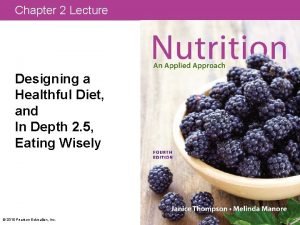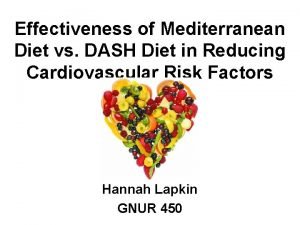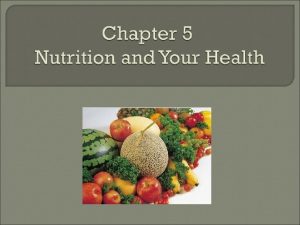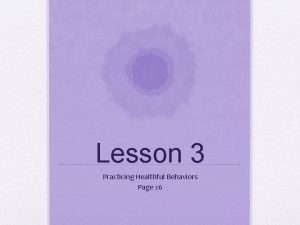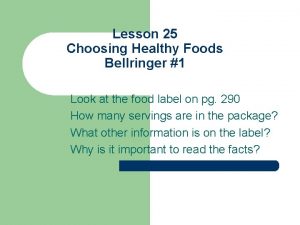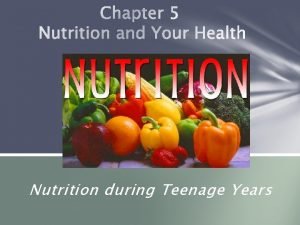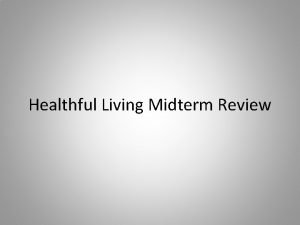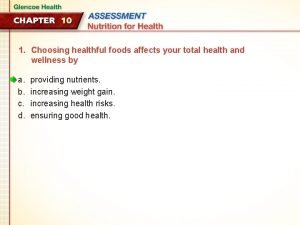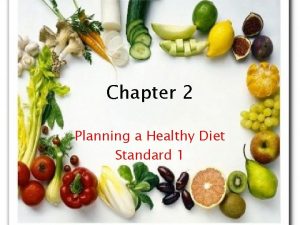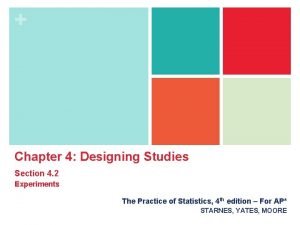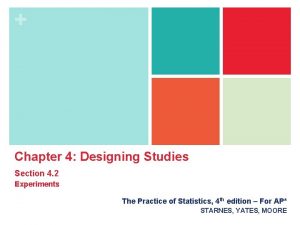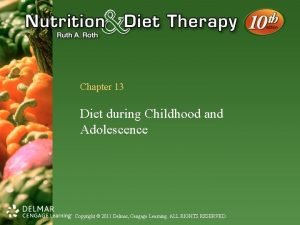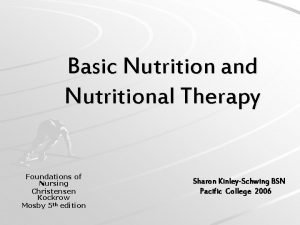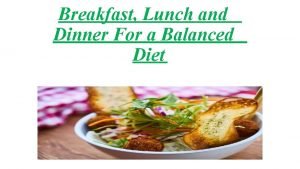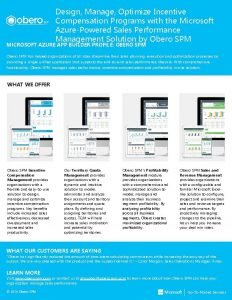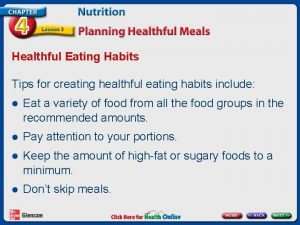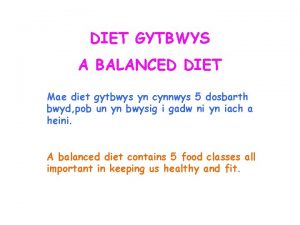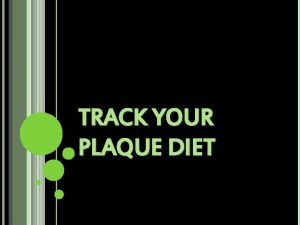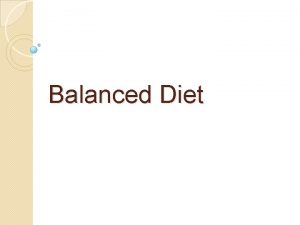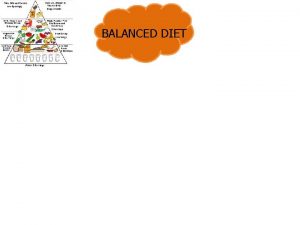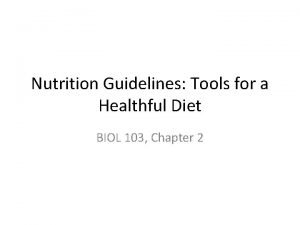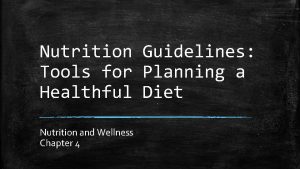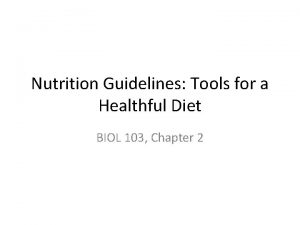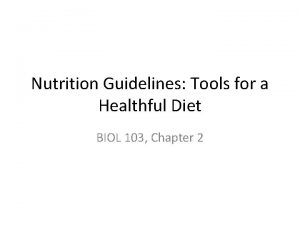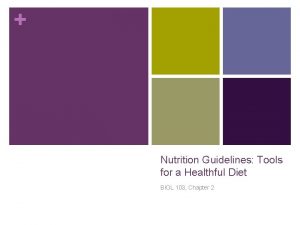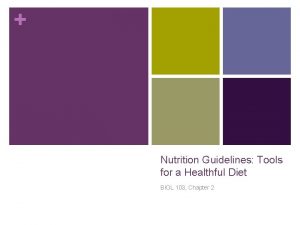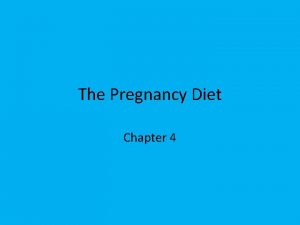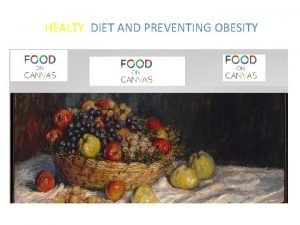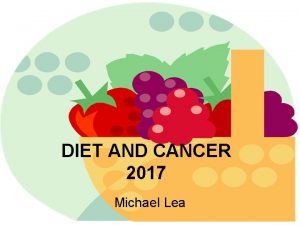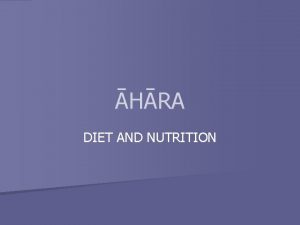Chapter 2 Lecture Designing a Healthful Diet and
























































- Slides: 56

Chapter 2 Lecture Designing a Healthful Diet, and In Depth 2. 5, Eating Wisely © 2015 Pearson Education, Inc.

What Is a Healthful Diet? A healthful diet is • Adequate • Moderate • Balanced • Varied © 2015 Pearson Education, Inc.

A Healthful Diet Is Adequate An adequate diet provides enough energy, nutrients, and fiber to support a person's health A diet adequate in one area can still be inadequate in another A diet adequate for one person may not be adequate for another © 2015 Pearson Education, Inc.

A Healthful Diet Is Balanced A balanced diet contains the right combinations of foods to provide the proper proportions of nutrients © 2015 Pearson Education, Inc.


© 2015 Pearson Education, Inc.

© 2015 Pearson Education, Inc.

A Healthful Diet Is Moderate Another key to a healthful diet is moderation A healthful diet contains the right amounts of foods for maintaining proper weight and nutrition © 2015 Pearson Education, Inc.

A Healthful Diet Is Varied Variety: eating many different foods from the different food groups on a regular basis A healthful diet is not based on only one or a few types of foods © 2015 Pearson Education, Inc.

Designing a Healthful Diet Tools for designing a healthful diet include: • Food labels • 2010 Dietary Guidelines for Americans • The USDA Food Patterns and My. Plate graphic • Other eating plans © 2015 Pearson Education, Inc.

Food Labels © 2015 Pearson Education, Inc.

Nutrition Facts Panel The Nutrition Facts Panel contains the nutrition information required by the FDA This information can be used in planning a healthful diet © 2015 Pearson Education, Inc.

Nutrition Facts Panel © 2015 Pearson Education, Inc.

Nutrition Facts Panel 1. Serving size and servings per container • Serving sizes can be used to plan appropriate amounts of food • Standardized serving sizes allow for comparisons among similar products © 2015 Pearson Education, Inc.

Nutrition Facts Panel 2. Calories and Calories from fat per serving • This information can be used to determine if a product is relatively high in fat © 2015 Pearson Education, Inc.

Nutrition Facts Panel 3. List of nutrients • Fat (total, saturated, and trans) • Cholesterol • Sodium • Carbohydrates • Protein • Some vitamins and minerals © 2015 Pearson Education, Inc.

Nutrition Facts Panel 4. Percent Daily Values (%DV) • Describe how much a serving of food contributes to your total intake of a nutrient • Based on a diet of 2, 000 Calories per day • Can be used to determine if a product is low or high in a particular nutrient • Based on: • Reference Daily Intakes (RDIs) for foods with a Recommended Dietary Allowance (RDA) value • Daily Reference Values (DRVs) for foods without an RDA value © 2015 Pearson Education, Inc.

Nutrition Facts Panel 5. Footnote • Contains general dietary advice for all people • Must be present on all food labels • Also compares a 2, 000 -Calorie diet with a 2, 500 -Calorie diet © 2015 Pearson Education, Inc.

Nutrient Claims on Food Labels The FDA has approved several claims related to health and disease If current scientific evidence about a health claim is not convincing, the label may have to include a disclaimer Structure–function claims such as "Builds stronger bones" can be made with no proof and therefore no actual benefits may be seen © 2015 Pearson Education, Inc.

FDA-Approved Terms and Definitions © 2015 Pearson Education, Inc.

FDA-Approved Terms and Definitions © 2015 Pearson Education, Inc.

USDA-Approved Health Claims © 2015 Pearson Education, Inc.

Health Claims Report Card © 2015 Pearson Education, Inc.

Dietary Guidelines for Americans • A set of principles developed by • U. S. Department of Health and Human Services • U. S. Department of Agriculture • Revised every 5 years (most recently in 2010) • Designed to • Promote health • Reduce the risk for chronic diseases • Reduce the prevalence of overweight and obesity © 2015 Pearson Education, Inc.

Dietary Guidelines for Americans Key DGA recommendations: • Balance Calories to maintain a healthy weight • Reduce consumption of foods and food components of concern, such as: • • Sodium Fat (especially saturated) Sugars Alcohol • Increase consumption of healthful foods and nutrients • Follow healthy and safe eating patterns © 2015 Pearson Education, Inc.

Comparing Nutrient Density © 2015 Pearson Education, Inc.

Comparing Nutrient Density © 2015 Pearson Education, Inc.

The USDA Food Patterns: My. Plate • Visual representation of the USDA Food Patterns • Released in 2011 • Replaces the previous My. Pyramid graphic • An interactive, personalized guide that can be accessed on the Internet © 2015 Pearson Education, Inc.

The USDA Food Patterns: My. Plate is intended to help Americans • Eat in moderation to balance Calories • Eat a variety of foods • Consume correct proportions of the recommended food groups • Personalize their eating plan • Increase their physical activity • Set goals for gradual improvement in their food choices and lifestyle © 2015 Pearson Education, Inc.

My. Plate Graphic © 2015 Pearson Education, Inc.

Mediterranean Diet My. Plate incorporates many features of the Mediterranean diet, in which • Olive oil is the primary fat • Daily foods are grains, legumes, nuts, vegetables, and cheese and yogurt • Eggs, poultry, fish, and sweets are eaten weekly, while red meat is eaten only monthly • Wine is included in moderation © 2015 Pearson Education, Inc.

Mediterranean-Style My. Plate © 2015 Pearson Education, Inc.

USDA Food Patterns Food groups emphasized in the USDA Food Patterns and My. Plate are • Grains • Vegetables • Fruits • Diary foods • Protein foods © 2015 Pearson Education, Inc.

Food Groups of the USDA Food Patterns © 2015 Pearson Education, Inc.

The Concept of Empty Calories is a concept introduced in the USDA Food Patterns • Calories from solid fats and/or added sugars that provide few or no nutrients • USDA recommends limiting empty Calories to a small number that fit your nutrient needs, depending on your • Age • Gender • Level of physical activity © 2015 Pearson Education, Inc.

Number and Size of Servings Amounts recommended from each food group in the USDA Food Patterns are based on your • Age • Gender • Level of physical activity • My. Plate uses the term ounce-equivalent (oz-equivalent): a serving size that is 1 ounce, or the equivalent © 2015 Pearson Education, Inc.

Serving Size Examples © 2015 Pearson Education, Inc.

Serving Size Examples © 2015 Pearson Education, Inc.

Food Portions Have Increased © 2015 Pearson Education, Inc.

My. Plate Variations Like the English-language version of My. Plate, the Spanish-language version recommends food groups, not specific food choices Ethnic foods or foods that match a vegetarian diet or other lifestyle preferences can be incorporated into My. Plate © 2015 Pearson Education, Inc.

Spanish Language Version of My. Plate © 2015 Pearson Education, Inc.

Other Eating Plans The DASH diet • Dietary Approaches to Stop Hypertension The exchange system for meal planning • Designed for people with diabetes • Food portions are organized according to the amount of carbohydrate, protein, fat, and Calories in each © 2015 Pearson Education, Inc.

Eating Out as Part of a Healthful Diet Eating in restaurants often involves • High-fat foods • Large portion sizes A restaurant meal can be equivalent to the recommended fat or Calorie intake for an entire day! © 2015 Pearson Education, Inc.

Nutritional Value of Fast Foods © 2015 Pearson Education, Inc.

Eating Out as Part of a Healthful Diet Tips for restaurant meals • Avoid all-you-can-eat buffets, breaded and fried foods, and cream and cheesy sauces • Substitute an appetizer or children's portion for a large meal, or share an entrée with a friend • Order broth-based soups; salads with dressing on the side; lean cuts of meat, vegetarian dishes, and chicken or fish burgers; steamed vegetables instead of potatoes or rice; and beverages with few or no Calories • Don't feel you must eat everything you're served • Skip dessert or have fruit © 2015 Pearson Education, Inc.

In Depth: Eating Wisely Hunger is a basic biological urge, while appetite is a psychological desire influenced by • Sensory data • Social, cultural, and emotional cues • Learning © 2015 Pearson Education, Inc.

Influences on Appetite © 2015 Pearson Education, Inc.

In Depth: Eating Wisely Diet analysis programs can help you evaluate the quality of your diet These include • My. Plate Supertracker • ESHA Research's My. Diet. Analysis • USDA's Nutrient Database for Standard Reference © 2015 Pearson Education, Inc.

In Depth: Eating Wisely Increase your awareness by eating mindfully • Focus only on eating by turning off or putting away distractions • Take your time and savor each bite • Focus on the smell, taste, texture, and temperature of food, as well as sensations of satisfaction or fullness • Pause between bites • Try eating silently © 2015 Pearson Education, Inc.

Mediterranean Diet Could Help Reduce Heart Disease PLAY © 2015 Pearson Education, Inc. ABC News Video: Mediterranean Diet Could Help Reduce Heart Disease

Calorie Check: How Many Servings Are You Eating? PLAY © 2015 Pearson Education, Inc. ABC News Video: Calorie Check: How Many Servings Are You Eating?

Menu Calorie Counts: How Accurate Are They? PLAY © 2015 Pearson Education, Inc. ABC News Video: Menu Calorie Counts: How Accurate Are They?

Crackdown on Food Labels: Many Not as "Healthy" as Claimed? PLAY © 2015 Pearson Education, Inc. ABC News Video: Crackdown on Food Labels: Many Not as "Healthy" as Claimed?

Miscounting Calories: Surprising New Diet Food Report PLAY © 2015 Pearson Education, Inc. ABC News Video: Miscounting Calories: Surprising New Diet Food Report

Blue Zones - Sardinian Diet PLAY © 2015 Pearson Education, Inc. ABC News Video: Blue Zones - Sardinian Diet

Calorie Count: Eat by the Numbers PLAY © 2015 Pearson Education, Inc. ABC News Video: Calorie Count: Eat by the Numbers
 Serving size examples
Serving size examples Mediterranean diet vs dash diet
Mediterranean diet vs dash diet 01:640:244 lecture notes - lecture 15: plat, idah, farad
01:640:244 lecture notes - lecture 15: plat, idah, farad Three strategies for handling anger in a healthful way
Three strategies for handling anger in a healthful way Chapter 5 nutrition guidelines tools for healthful eating
Chapter 5 nutrition guidelines tools for healthful eating Chapter 3 lesson 3 expressing emotions in healthful ways
Chapter 3 lesson 3 expressing emotions in healthful ways Chapter 11 nutrition and diet
Chapter 11 nutrition and diet Chapter 11 nutrition and diets
Chapter 11 nutrition and diets Product design and development plan example
Product design and development plan example Chapter 8 designing and managing service processes
Chapter 8 designing and managing service processes Designing and managing services kotler keller ppt
Designing and managing services kotler keller ppt Practicing healthful behaviors
Practicing healthful behaviors Choosing healthful foods lesson 25
Choosing healthful foods lesson 25 Effects of poor housing
Effects of poor housing Steps that enable you to make a healthful decision
Steps that enable you to make a healthful decision Steps that enable you to make a healthful decision
Steps that enable you to make a healthful decision A guide for making healthful daily food choices
A guide for making healthful daily food choices Chapter 10 lesson 3 healthy food guidelines
Chapter 10 lesson 3 healthy food guidelines In the help strategy the h stands for healthful
In the help strategy the h stands for healthful Melissa dobbins chocolate milk
Melissa dobbins chocolate milk A useful tool for making healthful daily food choices
A useful tool for making healthful daily food choices Your body uses carbohydrates by breaking them down into *
Your body uses carbohydrates by breaking them down into * Chapter 2 planning a healthy diet
Chapter 2 planning a healthy diet Chapter 7 designing organizational structure
Chapter 7 designing organizational structure Chapter 7 designing organizational structure
Chapter 7 designing organizational structure What is matched pairs
What is matched pairs Evaluating the variables affecting channel structure are
Evaluating the variables affecting channel structure are Chapter 4 designing studies
Chapter 4 designing studies Designing and delivering oral and online presentations
Designing and delivering oral and online presentations Architecture is the art and science of designing buildings
Architecture is the art and science of designing buildings Human resource management lecture chapter 1
Human resource management lecture chapter 1 Chapter 1 introduction to human resource management
Chapter 1 introduction to human resource management Human resource management lecture chapter 1
Human resource management lecture chapter 1 Global strategy on diet physical activity and health
Global strategy on diet physical activity and health Eating a balanced diet during childhood and adolescence
Eating a balanced diet during childhood and adolescence Nutrition fundamentals of nursing
Nutrition fundamentals of nursing Balanced diet breakfast lunch dinner
Balanced diet breakfast lunch dinner The prophets diet
The prophets diet Chapter 11 managing weight and eating behaviors
Chapter 11 managing weight and eating behaviors Mentos and diet pepsi
Mentos and diet pepsi The process of designing and maintaining an environment
The process of designing and maintaining an environment Computer aided embroidery
Computer aided embroidery Designing pay levels mix and pay structures
Designing pay levels mix and pay structures Steps in designing hrd programs
Steps in designing hrd programs How to designing and managing service processes
How to designing and managing service processes Designing and managing products
Designing and managing products Chapter 4 product and service design pdf
Chapter 4 product and service design pdf Analyzing work and designing jobs
Analyzing work and designing jobs Designing and managing services
Designing and managing services Dialogues
Dialogues Designing and implementing brand marketing programs
Designing and implementing brand marketing programs Brand hierarchy levels
Brand hierarchy levels Designing and managing integrated marketing communications
Designing and managing integrated marketing communications Test of detail
Test of detail Process of textbook development
Process of textbook development Obero spm
Obero spm The act of designing the company's offering and image
The act of designing the company's offering and image
